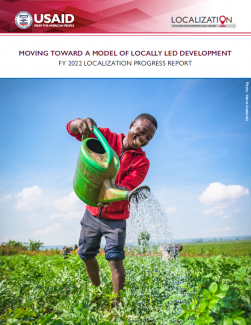USAID is committed to shifting funding and decision-making power to the people, organizations, and institutions that are driving change in their own countries and communities. Experience shows that local leadership over development and humanitarian goals and programming is important for equity, effectiveness, and sustainability. Through localization, a set of internal reforms, actions, and behavior changes to orient the Agency’s work around local actors’ priorities and strengthen local systems, USAID strives to advance locally led development and humanitarian response, in which local actors set their own agendas, develop solutions, and mobilize the capacity, leadership, and resources to make those solutions a reality.
In November 2021, Administrator Power announced two targets for USAID in pursuit of its localization goals. First, by Fiscal Year (FY) 2025, USAID will direct a quarter of its funding directly to local partners. And second, by 2030, at least half of USAID programs will create space for local actors to exercise leadership over priority setting, activity design, implementation, and defining and measuring results.
This report provides the first status update on USAID’s progress toward these targets. In FY 2022, Direct Local Funding to individuals, organizations, or corporations based and legally organized in a country where they implement USAID-funded work reached nearly $1.6 billion, or 10.2 percent of obligations.1 This is the highest level and percent of Direct Local Funding in at least a decade. Missions and other overseas units led these efforts, directing 18 percent of attributable acquisition and assistance obligations to local partners. In addition, in FY 2022, USAID provided $57 million to partners working regionally and another $199 million in government-to-government (G2G) assistance.

